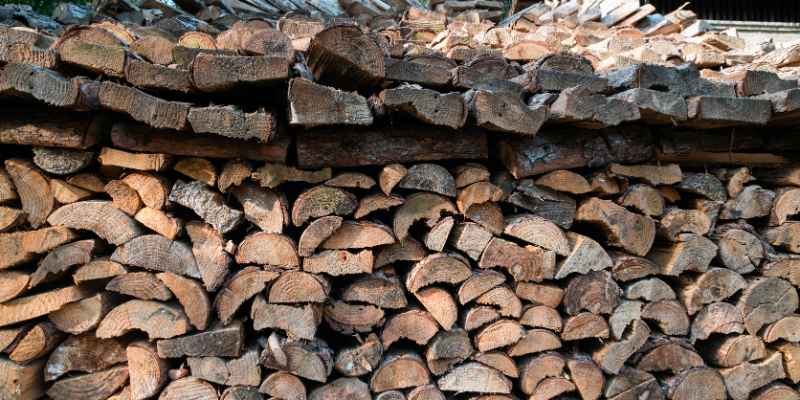To make a kiln to dry wood, construct a small enclosed structure using heat-resistant materials such as bricks or metal sheets, ensuring proper insulation and ventilation.
Introduction To Wood Drying Kilns
Wood drying kilns are essential for the process of removing moisture from timber, making it suitable for various applications. In this section, we will explore the purpose of drying wood, as well as the benefits of using a kiln for this process.
Purpose Of Drying Wood
Drying wood serves the purpose of reducing its moisture content to a level that is suitable for its intended use. This is crucial for preventing decay, improving strength, and minimizing shrinkage once the wood is incorporated into a project.
Benefits Of Using A Kiln
Using a kiln for wood drying offers several advantages. It allows for precise control of temperature and humidity levels, resulting in a more uniform drying process. Additionally, kiln-dried wood is less prone to warping and cracking, making it ideal for high-quality woodworking projects.
Types Of Wood Drying Kilns
When it comes to drying wood, there are different types of wood drying kilns that are commonly used. Each type of kiln offers its own set of advantages and is suitable for different situations. Understanding the different types of wood drying kilns can help you choose the best option for your specific needs.
Conventional Kilns
Conventional kilns are the traditional method for drying wood. They use external heat sources such as gas or wood to create the necessary heat for drying the wood. The process involves controlling the temperature, humidity, and airflow to achieve the desired drying rate.
Dehumidification Kilns
Dehumidification kilns are modern and energy-efficient. They use a dehumidifier to remove moisture from the air, creating the ideal environment for drying wood. These kilns are suitable for smaller-scale operations and can be more cost-effective in the long run due to their lower energy consumption.
Solar Kilns
Solar kilns utilize solar energy to dry wood. They are an environmentally friendly option and can be a cost-effective choice for those with access to ample sunlight. These kilns use solar heat to dry the wood, reducing the need for external energy sources and minimizing operational costs.
Essential Materials And Tools
When it comes to making a kiln to dry wood, having the essential materials and tools is crucial for a successful construction. To ensure that the kiln is properly built and functions effectively, it is important to gather the necessary items before starting the project.
Construction Materials
- Insulating firebricks
- Fire-resistant mortar
- Steel rebars
- Sheet metal
- Aluminum flashing
- Thermocouples
- High-temperature insulation
- Fire-resistant paint
Measuring And Cutting Tools
- Tape measure
- Straight edge
- Pencil
- Circular saw
- Table saw
- Chop saw
- Hammer
- Level
Designing Your Kiln
When making a kiln to dry wood, the design is crucial. Consider factors such as size, airflow, and insulation to ensure efficient and effective wood drying. Proper planning and construction are essential for designing a kiln that meets your specific wood drying needs.
Designing Your Kiln is an essential part of the wood-drying process. A well-designed kiln can help you dry wood faster and more efficiently. The size and capacity of your kiln, as well as ventilation and air flow considerations, are critical factors that need to be considered during the design process. In this section, we’ll discuss these factors in detail.
Determining Size And Capacity
The size and capacity of your kiln will depend on the amount of wood you need to dry. Consider the following factors when determining the size and capacity of your kiln:
- The type of wood you’re drying
- The thickness of the wood
- The moisture content of the wood
- The amount of wood you need to dry at one time
Once you have determined these factors, you can calculate the size and capacity of your kiln. It’s essential to ensure that your kiln is not too small or too large. A kiln that is too small will not be able to dry enough wood, while a kiln that is too large will waste energy.
Ventilation And Air Flow Considerations
Proper ventilation and air flow are crucial for the wood-drying process. The following considerations must be taken into account:
- The location of the kiln
- The type of ventilation system you’ll use
- The direction of airflow
- The number and placement of vents
- The humidity and temperature levels inside the kiln
You must ensure that your kiln has proper ventilation and air flow to prevent mold growth and uneven drying. The location of your kiln should be well-ventilated and away from any flammable materials. You can use natural or mechanical ventilation systems, depending on your needs.
In conclusion, designing your kiln is a crucial aspect of the wood-drying process. You must consider the size and capacity of your kiln, as well as ventilation and air flow considerations. These factors will ensure that your kiln is efficient and effective in drying wood.
Step-by-step Kiln Construction
Building The Frame
Construct a sturdy frame using treated lumber.
- Ensure the dimensions accommodate the wood piles.
- Use a level to check for evenness.
- Secure corners with metal brackets.
Installing Insulation And Heating Elements
Add insulation inside the frame to regulate temperature.
- Apply heat-resistant insulation boards.
- Install heating elements evenly throughout.
- Connect elements to a thermostat for control.
Setting Up A Monitoring System
When it comes to drying wood in a kiln, setting up a monitoring system is crucial. This will help to ensure that the wood is dried evenly and that the kiln is functioning properly. A monitoring system typically includes temperature and humidity gauges, as well as automated controls.
Temperature And Humidity Gauges
Temperature and humidity gauges are essential for monitoring the conditions inside the kiln. These gauges should be placed in several locations throughout the kiln to ensure that the readings are accurate and consistent. Ideally, the gauges should be digital and have a range of at least 0-100 degrees Celsius for temperature and 0-100% for humidity.
Automated Controls
In addition to temperature and humidity gauges, automated controls can be used to maintain optimal drying conditions. These controls can be set to adjust the temperature and humidity levels automatically, based on the readings from the gauges. This helps to ensure that the conditions inside the kiln remain consistent and that the wood is dried evenly.
When setting up a monitoring system for your kiln, it is important to ensure that all components are working properly and that the readings are accurate. Regular maintenance and calibration are essential to ensure that the system is functioning as it should.
| Benefits of Setting Up a Monitoring System |
|---|
| Ensures even drying of wood |
| Prevents over-drying or under-drying |
| Improves kiln efficiency |
| Reduces risk of damage to wood |
Overall, setting up a monitoring system is an important step in the process of drying wood in a kiln. By monitoring temperature and humidity levels, and using automated controls to maintain optimal conditions, you can ensure that the wood is dried evenly and that the kiln is functioning efficiently.
Operating Your Kiln Safely

Safely operating a wood-drying kiln is crucial for effective and secure wood drying. To successfully dry wood, it is essential to understand the kiln’s operation, including temperature and humidity control, proper stacking, and airflow management. By following safety protocols and guidelines, one can ensure the efficient and safe operation of a wood-drying kiln.
Safety Precautions
Maintenance Tips
Operating Your Kiln Safely is crucial to ensure the well-being of yourself and others. Follow these safety precautions and maintenance tips to prevent accidents and maintain the efficiency of your wood drying kiln.
Safety Precautions
- Wear protective gear, including gloves and safety goggles.
- Ensure proper ventilation in the kiln area.
- Regularly inspect electrical components for any signs of damage.
Maintenance Tips
- Clean the kiln regularly to prevent dust buildup.
- Check and replace any worn-out or damaged parts promptly.
- Monitor the temperature and humidity levels consistently.
Troubleshooting Common Kiln Issues
When drying wood in a kiln, you may encounter various issues that can affect the quality of the final product. Understanding and addressing these common problems is crucial for successful wood drying. Below are some common kiln issues and troubleshooting tips:
Temperature Fluctuations
Uneven temperatures can lead to inconsistent drying. Check the heating elements and fans for proper functioning. Ensure good air circulation inside the kiln.
Wood Drying Defects
Warped wood may result from improper stacking. Stack the wood uniformly to prevent warping. Check for mold growth, which can occur due to high humidity levels.
Maximizing Efficiency
Learn how to maximize efficiency in wood drying by building your own kiln. With simple materials and a few steps, you can create a cost-effective solution for drying wood, ensuring it’s ready for use in your projects. This DIY approach helps you save time and resources, making the most of your wood drying process.
Maximizing Efficiency is crucial when making a kiln to dry wood. Optimizing Drying Cycles, and utilizing Energy-saving Strategies are the keys to achieving this efficiency. By doing so, you can reduce the amount of time and energy required for drying the wood while ensuring that the quality of the wood remains high.
Optimizing Drying Cycles
To optimize the drying cycles, you need to understand the moisture content of the wood. The ideal moisture content for most types of wood is around 6-8%. You can use a moisture meter to measure the moisture content of the wood. Once you know the moisture content, you can adjust the drying cycle accordingly.
Energy-saving Strategies
There are several energy-saving strategies that you can use when making a kiln to dry wood. One of the most effective strategies is to insulate the kiln properly. Proper insulation helps to reduce heat loss, which in turn reduces energy consumption.
Another strategy is to use a heat recovery system. This system captures the heat that is generated during the drying process and recycles it back into the kiln. This can significantly reduce the amount of energy required to dry the wood.
You can also use a dehumidifier to remove moisture from the air inside the kiln. This reduces the amount of energy required to heat the air and speeds up the drying process.
In conclusion, by Optimizing Drying Cycles, and utilizing Energy-saving Strategies, you can maximize efficiency when making a kiln to dry wood. This helps to reduce the amount of time and energy required for drying the wood while ensuring that the quality of the wood remains high.
Real-world Examples
Learn how to make a kiln to dry wood with real-world examples. Discover step-by-step instructions for creating your own kiln and efficiently drying wood for various projects. Master the art of wood drying with this practical guide.
Case Studies
When it comes to building a DIY kiln for drying wood, looking at case studies can provide valuable insights.
DIY Kiln Success Stories
Successful DIY kiln projects inspire and guide others in creating their own efficient wood-drying setups.
Conclusion And Next Steps
Explore how to make a kiln to efficiently dry wood. Take the first step by constructing a simple yet effective kiln following these guidelines. Once completed, proceed to the next steps of loading and monitoring the drying process.
Congratulations on successfully building your own kiln for drying wood! Now that you have your kiln up and running, it’s time to evaluate its performance and explore advanced techniques.
Evaluating Kiln Performance
To ensure that your kiln is working efficiently, you’ll need to monitor its temperature and humidity levels regularly. Use a thermometer and hygrometer to measure the temperature and humidity inside the kiln. Record the readings and make adjustments as necessary.
You should also inspect your wood regularly to ensure that it’s drying evenly and without any defects. Check the ends of the wood to see if they are splitting or cracking. If they are, you may need to adjust the temperature or humidity levels in your kiln.
Advanced Techniques For Experienced Users
If you’re an experienced user and want to take your wood drying to the next level, there are some advanced techniques you can try. One technique is to use a solar kiln, which uses the sun’s energy to dry the wood. Another technique is to use a vacuum kiln, which can dry wood much faster than a traditional kiln.
You can also experiment with different types of wood and drying methods to achieve different results. For example, you can try drying wood at different temperatures or with different levels of humidity to see how it affects the wood’s color, strength, and other properties.
In conclusion, building a kiln to dry wood is a great way to save money and get the most out of your wood. With a little bit of experimentation and practice, you can become an expert at drying wood and achieve the results you want.

Frequently Asked Questions
How Can I Build A Kiln To Dry Wood At Home?
Building a kiln to dry wood at home is a simple process. First, gather the necessary materials such as plywood, insulation, and a heating source. Construct a box-like structure using the plywood and insulate it with the insulation material. Install the heating source, such as a heater or a dehumidifier, and ensure proper ventilation.
Finally, monitor the temperature and humidity levels inside the kiln to ensure optimal drying conditions.
What Temperature Should I Set In The Kiln To Dry Wood?
The ideal temperature for drying wood in a kiln is between 130 to 160 degrees Fahrenheit. This temperature range allows for efficient moisture removal without causing damage to the wood. It is important to monitor the temperature closely and make adjustments as needed to ensure the wood dries evenly and without excessive cracking or warping.
How Long Does It Take To Dry Wood In A Kiln?
The drying time for wood in a kiln can vary depending on several factors, such as the type of wood, thickness, and initial moisture content. On average, it takes about 4 to 8 weeks to dry wood in a kiln.
However, it is important to regularly check the moisture content using a moisture meter to determine when the wood is fully dried and ready for use.
Can I Dry Wood Without A Kiln?
Yes, it is possible to dry wood without a kiln. One method is air-drying, where the wood is stacked and exposed to natural air circulation. This process can take several months or even years, depending on the wood species and thickness.
Another method is using a dehumidification kiln, which removes moisture from the air to dry the wood. However, the drying time may be longer compared to a conventional kiln.
Conclusion
Building a kiln for drying wood can be a rewarding DIY project. By following the steps outlined, you can create a functional kiln that meets your needs. Remember to prioritize safety and proper ventilation throughout the process. Enjoy the benefits of efficiently dried wood for your projects.


